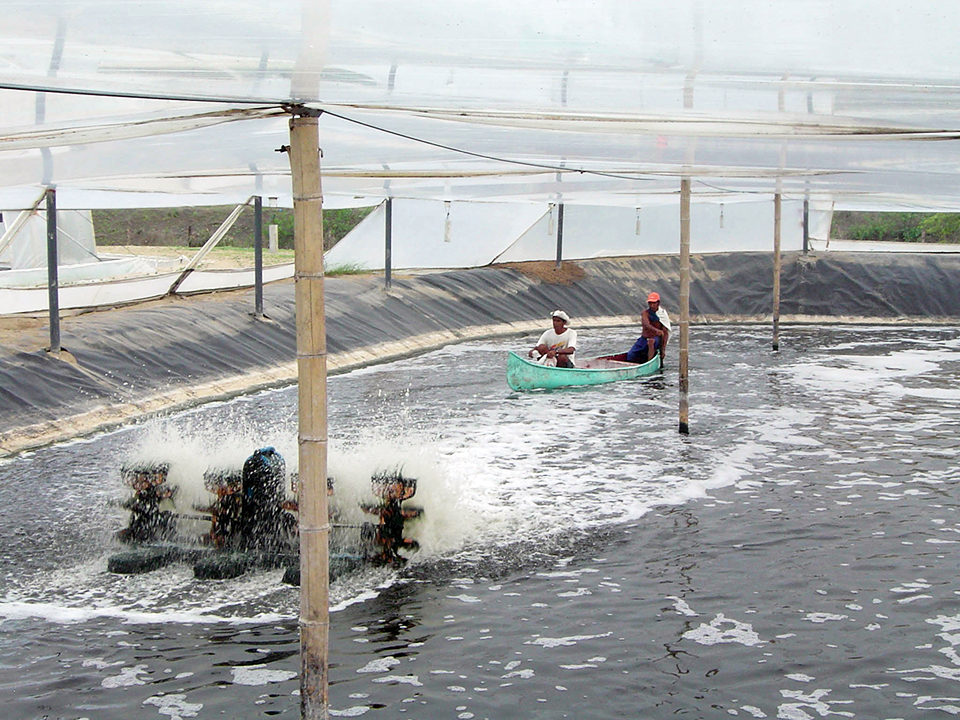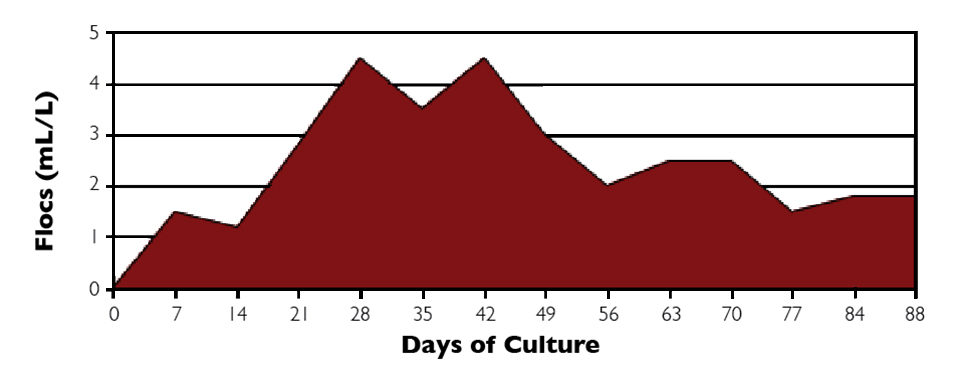Important to understand carrying capacity and biological, physical and chemical factors

In Latin America, where most shrimp farms operate semi-intensively, Langostinera Florida is one of only a handful of facilities that operate as intensive farms.
Located near Zorritos in the department of Tumbes in northern Peru, Langostinera Florida started operations in 2004 and currently includes a total production area of about 2 hectares (ha). Its four large ponds – one 1,000-square-meter nursery pond, two 5,000-square-meter grow-out ponds and one 9,000-square-meter grow-out pond – are all lined with 0.75-mm high-density polyethylene.
The ponds have depths of 1.1 to 1.5 meters and are covered with flat greenhouses. The operation is managed by only seven people: three production workers, one chemist, one biologist and two security guards.
Water quality
Oceanic water is brought in through well points. New water is fertilized using various inorganic chemicals about 10 days before stocking and then inoculated with “old” water from one of the existing ponds, which establishes a robust diatom bloom. This protocol, established through experience, relies heavily on a thorough understanding of how chemical processes influence pond water quality.
Mechanical aeration is provided through 2-hp surface paddlewheels at 28-32 hp/ha. Production is targeted at 20-25 metric tons (MT)/ha/cycle. The system is managed to promote mixed populations of autotrophic and heterotrophic (biofloc) microorganisms.
Water quality variables such as dissolved oxygen, temperature, salinity and pH are measured twice daily, and ammonia, nitrite, nitrate and phosphate levels are determined twice per week. Water temperatures in the ponds fluctuate little during the year, with a typical range of 29 to 31 degrees-C, while salinities reflect a range of 35 to 47 ppt. Dissolved oxygen is managed through mechanical aeration to maintain early morning levels of at least 5mg/L and late afternoon levels of 4.5 mg/L.

Stocking
Shrimp postlarvae (PLs) are procured from a local commercial hatchery and stocked into the nursery pond at around 800 PLs per square meter. After 30 days, when the shrimp reach an average weight of about 1.4 grams with survival rates of 88 to 90 percent, the animals are transferred to growout ponds and stocked at 80 animals per square meter.
Feeding
Commercial 35 percent-protein feeds from a local manufacturer are used throughout the production cycle. Feed consumption is monitored and adjusted using eight feed trays per ha. Feed is applied manually three to five times daily, depending on the production phase, with total feed amounts evenly divided among the applications (Table 1). The last feed application takes place at around 8 p.m., and feed conversion typically averages about 1.4. In typical cycles, individual shrimp receive 0.15-0.40 grams feed/day.
Belsher, Feeding protocol, Table 1
| Culture Period (days) | Feed Size (mm) | Daily Feedings |
|---|---|---|
| 0-10 | 0.3-0.8 | 5 |
| 11-30 | 0.4-1.8 | 4 |
| 31-45 | 2.0 | 4 |
| 46-harvest | 2.5 | 3 |
Production management
Animals are monitored twice weekly during the growout cycle to collect production and biometric data and also for health monitoring. The shrimp stocked into production ponds typically reach around 23 g after 75 days of culture for a total culture time including nursery of 105 days. Survival rates average 90 to 95 percent.
Harvests typically range from 17 to over 23 MT per ha. Overall, the system is capable of producing 75 MT/ha/year on three cycles with harvested animals averaging 23 to 25 grams.
Different production strategies have been used, including the use of partial harvests or just one complete, final harvest at the end of the grow-out cycle. No probiotics are used in the nursery or production ponds, but daily sugar applications of about 20 to 25 kg are routine. The sugar promotes a high carbon:nitrogen ratio that favors heterotrophic bacteria and the formation of bioflocs, which can contribute significant nutritional benefits to the shrimp (Fig. 1).

One important observation is that at water temperatures over 30 degrees-C, there are no incidences of white spot syndrome. However, temperatures over 33 degrees-C can affect the growth of animals and the digestibility of feeds.
Perspectives
Langostinera Florida is an excellent example of the viability of greenhouse-enclosed, intensive shrimp farming under controlled conditions in areas of Latin America and elsewhere, where diseases like white spot syndrome have seriously affected the industry. In these systems, though, it is very important to properly understand the carrying capacity and the biological, physical and chemical factors that affect it, so proper management techniques can be implemented.
Author’s Note: I recently had the opportunity to visit Langostinera Florida, where I saw a very high level of production technology implemented. This is an excellent example of intensive shrimp farming being viable in Latin America. The company now stands ready to expand based on its proven technology.
(Editor’s Note: This article was originally published in the March/April 2011 print edition of the Global Aquaculture Advocate.)
Authors
-
Dr. Dennis Belsher
Langostinera Florida
Panamericana Norte Km. 1222
Acapulco Zorritos, Tumbes, Peru[109,111,99,46,99,111,108,102,112,109,105,114,104,115,64,114,101,104,115,108,101,98,111,100]
-
Miguel León
Langostinera Florida
-
Máximo Quispe
Nicovita – Alicorp
Callao, Perú
Tagged With
Related Posts

Intelligence
A land grab for salmon (and shrimp) in upstate New York
The operators of Hudson Valley Fish Farm see their inland locale as a pilot to prove that land-based fish farming, located in close proximity to major metropolitan markets, can be successful.

Innovation & Investment
Brazilian shrimp farmers eye new horizons
After concentrating mainly on the domestic market, the Brazilian Shrimp Farmers Association says producers are returning to international trade and competition, seeking intensified production and expansion.

Health & Welfare
Building a better shrimp nursery, part 1
Shrimp nursery systems offer an important opportunity to increase profits. Properly designed and operated nurseries are highly biosecure facilities to grow postlarvae at very high densities.

Innovation & Investment
High-density shrimp producer wins innovation award
Camanor Produtos Marinhos Ltda. operates a land-based, multi-species concept for sustainable shrimp production called AquaScience. The Global Aquaculture Alliance has named Camanor the winner of its annual Aquaculture Innovation and Leadership award. Director Werner Jost discusses the process.


